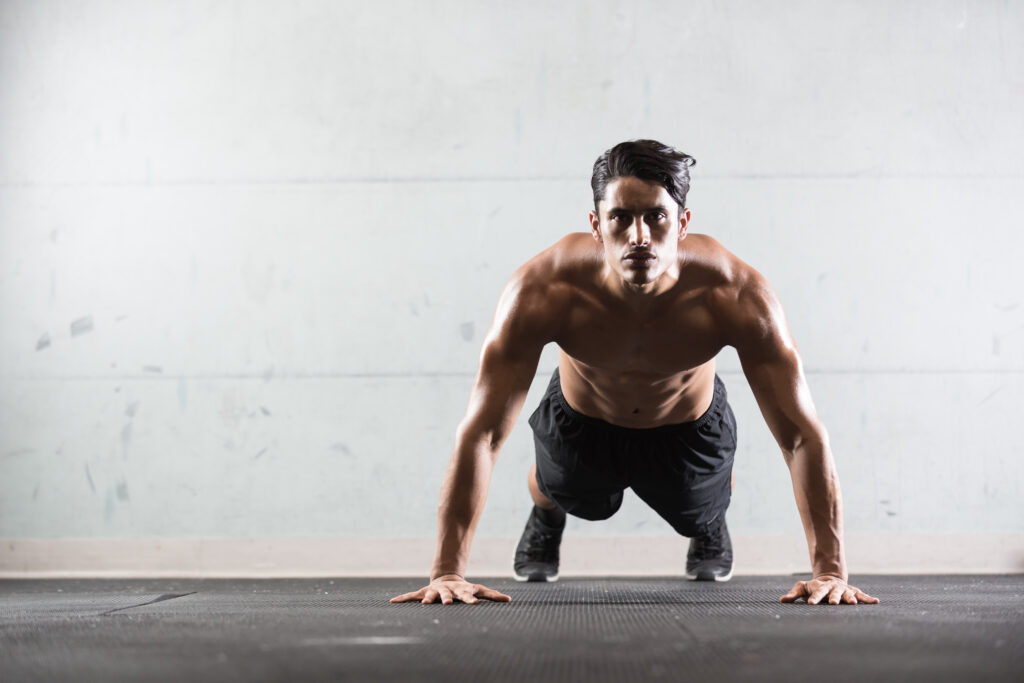“And this,” Algieri says later, “isn’t close to how I train.”
But it’s enough to show why boxing training has seen a mini-resurgence among celebrities (Google Adriana Lima’s workout), why Gleason’s is filled with sweat-soaked youngsters, and why this is a perfect changeup to your typical cardio or HIIT routine. Algieri, fresh off serving as nutritionist for Danny Jacobs, is only teaching basics—but the basics will still burn oodles of calories and craft strong legs and a carved midsection.
Here are five things I learned from my first boxing workout:
1) Boxing kills your legs.
Just bouncing around in a boxer’s stance is a decent leg workout. And the stance is the starting point for everything that follows. To find your boxer’s stance, stand straight, and then take a step backwards with your right leg (if you’re right-handed), as far as you can, without turning your hips.
Now, turn that right foot outwards, and shift it a few inches to the right, then lift the heel of that foot off the ground. Center your weight and bend your knees. That’s your stance. You’ll maintain this position for much of any boxing workout. Any time you need to dodge, Algieri says, you’ll bend at the knees, just low enough to escape any imaginary punch.
By workout’s end, I’ve done at least 80 uneven squats, enough that my quads and hips are feeling it.
2) Boxing is all old school.
Basketball and football training have grown increasingly scientific, but you won’t find any trace of sports science at Gleason’s. Algieri, who has a master’s degree in clinical nutrition, pushes pomegranate juice and dons a heart-rate monitor when he trains alone, but he’s an outlier in a sport that still views its bell as “high-tech”.
“I think boxing is a little bit of an old-world mentality,” Algieri says. “It’s very antiquated from a sports science aspect.”
Ideas for loosening and priming soft tissues for workouts haven’t reached the boxing world just yet; there’s not a foam roller or Power Plate in sight. While football coaches are using GPS technology to track the velocity of players and NBA teams have begun vigorously charting player sleep habits, even at elite levels, boxing trainers don’t have such discussions, Algieri says.
3) It’s not easy to master the uppercut.
The power for each and every punch is generated by an aggressive and violent rotation through the hips and core. That movement is somewhat easy to learn for simple straight-ahead jabs, but the uppercut isn’t quite as natural. To generate power on an uppercut, you actually need to squat (there it is again!) slightly in a boxer’s stance, then rotate through your hips and drive your fist straight up and forward.
So nuanced is a perfect uppercut that it’s a key reason boxers often tear their biceps tendons and labrums, Algieri says.
4) Boxing is a core killer.
After shadowboxing long enough to learn all four main punches (left and right jabs, left and right uppercuts), then doing some light work with a partner, Algieri takes us over to the heavy bag for six 30-second intervals of relentless jab-throwing, and it’s here that my core takes a serious pounding.
Delivering each punch with proper hip and core snap generates the power to get the bag moving, but it leaves my abs crying at the end of each interval.
And since we’re trying to build that core strength, Algieri pushes us to more core work afterwards, focusing on off-center planks and feet-elevated Russian twists. On their own, the two movements aren’t that hard, but after all that boxing, they’re shredding my midsection.
5) Boxing doesn’t include “rest periods.”
Crossfitters often scale workouts when fatigue sets in, bodybuilders fully rest between sets, and HIIT workouts leave brief rest periods, but there’s never supposed to be true rest here. Boxers often train with no real breather, conditioning themselves for boxing matches that offer just a minute between 3-minute rounds.
Algieri provides a 15-second breather between sets on the heavy bag, but that’s only a break from punching. During that period, we’re told to bounce back and forth in our boxer’s stance or do squats.
“There’s really no time to drop the intensity,” Algieri says. “You’re supposed to fight through.”
6) Boxing is best used as a changeup.
Algieri’s boxing workout burns plenty of calories and gets plenty ofmuscles firing, but even he admits that it shouldn’t carry a trainingregimen. Why? Because it allows for no balanced muscle recruitment unless you’re coordinated enough to switch between righty and southpaw stances. (Spoiler alert before you try: You’re not.)
“It’s not a symmetrical sport,” Algieri says. “It’s just not.”
That’s why Algieri supplements his own boxing work with classic weight room work, doing plenty of bench presses, deadlifts and front squats when he’s not prepping for a fight.
“In between,” he says, “I think it’s important to step back from the sport.”
This article was originally published on MensHealth.com












